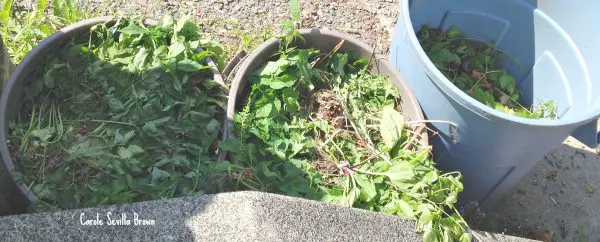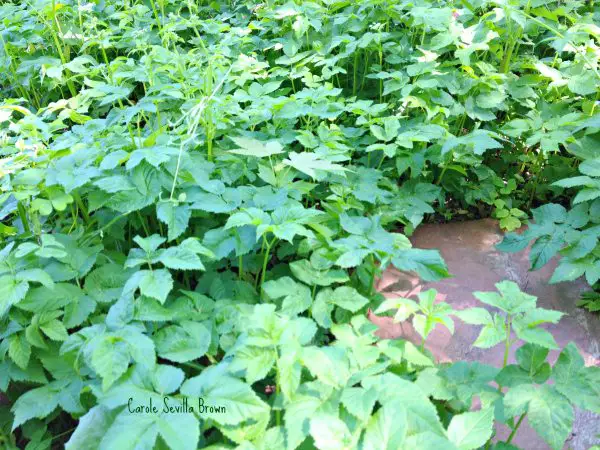The Agony of Bishop’s Weed
I’ve been doing battle for 14 years now with an invasive insidious persistent thug called Bishop’s Weed, also known as Goutweed or Snow On The Mountain (Aegopodium podagraria).
Every year I swear I’m going to get the Bishop’s Weed all pulled out in early spring, and well before the time that it flowers because Bishop’s Weed, a highly invasive plant can produce a prodigious amount of seeds, and you really don’t want this plant reproducing anywhere near your wildlife garden!
But, life has a way of intervening and one spring I’ll walk out the door and those white umbels in flower will be taunting me. “Ha Ha, it says. I’ve won again.” Such was the case last Sunday morning when I had planned on having a birding adventure at Brigantine National Wildlife Refuge.
When I saw the Bishop’s Weed flowers, I immediately dropped everything and went to work to get it removed from my front garden.
Why?
Bishop’s Weed (Aegopodium podagraria) makes a thick carpet in garden beds, and also into woodland natural areas where it has escaped from gardens, and this thick carpet wipes out all the native spring ephemerals, blocking their access to the sun, outcompeting them for resources, and keeping them from being able to grow.
I love my Trilliums and other spring ephemerals far too much to allow them to be blocked by the invasive thug that is Bishop’s Weed!
So I pulled up a trash can and got to work. It’s been kind of like monsoon season here in southeastern Pennsylvania lately, so the ground was wet enough to make trying to pull out most of the root a bit easier.
Bishop’s Weed is a sneaky plant. From its long stoloniferous roots it will send up plant stalks–right next to the flower stems of your favorite native woodland plants, making it very difficult to pull it without also pulling out your natives.
When Debra arrived home from band practice expecting to leave for our birding adventure, I was armpit deep in a big patch of Bishop’s Weed, and none to happy that I hadn’t gotten it pulled or cut back before it started to flower.
She graciously grabbed another trashcan and went to work in the Goutweed patch, helping me to try to get my nemesis plant under control.

Three full trashcans and 5 hours later, we were very proud of ourselves for a job well done–until next weekend when we’ll have to go cut it back or pull it again…..
Thursday morning–5 DAYS after filling those trashcans–I noticed that the Bishop’s Weed in the trash cans was actually blooming. Unbelievable! It’s like it just won’t ever die. Even having been pulled out of the garden, it had happily re-rooted itself and with a taunting smile was blooming IN THE TRASH CAN.



5 days after pulling Bishop’s Weed and trashing it, it is blooming again!
And one other thing. For several years now I’ve gotten what I thought was Poison Ivy, even though I had never before been susceptible to it in my many years of landscaping. But recently after working in my garden I’ve gotten a blistery rash that itches so bad I make myself bleed from scratching it in my sleep.
Guess what? I now don’t think it’s Poison Ivy (but I’m not willing to go rub some Poison Ivy leaves on my arms to prove it, LOL). In doing some research for this article, I discovered that Bishop’s Weed can be a major skin irritant and have an itchy painful rash. Just one more reason to hate on the Goutweed. I feel like I’ll need to get a hazmat suit now so I can deal with getting rid of my nemesis plant.
Invasive Bishop’s Weed
Bishop’s Weed (Aegopodium podagraria) is native to Europe, northern Asia, and Siberia and was brought to this country as an ornamental plant. It was first noticed to have escaped cultivation and become invasive in Rhode Island in 1863.
Also known as Goutweed or Snow-on-the-Mountain, it wreaks havoc in moist, partly shaded woodlands and disturbed areas. It forms a dense mat that prohibits other plants from establishing.
This trait is especially harmful in natural wooded areas where it outcompetes native plants. Because of this, many native woodland plants are now highly endangered.
Native plants provide value for wildlife and contribute to ecosystem services. When invasive plants block out native plant communities, we are destroying wildlife value and contributing to less healthy ecosystems.
Bishop’s Weed (Goutweed, Snow-on-the-Mountain) is banned for sale in Connecticut, Massachusetts, and Vermont, and is considered a noxious pest from Eastern Canada to Georgia and into the midwest, plus is invasive in the Pacific Northwest.
Bishop’s Weed has stoloniferous roots that spread far and wide under the soil. These greedy water seekers will suck up ALL of the water and keep nearby native plants from getting the moisture they need.
“Snow On The Mountain” sounds like such a pretty name for Aegopodium podagraria doesn’t it? But Ursula Vernon describes naming invasive plants perfectly:
If we really want to change people’s minds about invasive plants, I think we need to re-name them. Plenty of weeds could stand the re-branding treatment. Wild morning-glory sounds marvelous, exactly the sort of thing you’d put in a soap, but if we insist on calling it bindweed, we may get somewhere. Goutweed ought to be CALLED goutweed, and not dressed up as “snow-on-the-mountain.” Himalayan blackberry could probably be called “ravening monsterthorn” without anybody who is familiar with it complaining. And I’d pay good money to get the silk tree renamed to the “killer mayhembush.”
Eradicating Bishop’s Weed
The trouble is, pulling the invasive Goutweed is just a temporary measure. It’s root stolons travel far and wide underground, and unless you get every tiny speck of root out of your wildlife garden it’s going to keep coming back. I know. I’ve been pulling it for 14 years now. My neighbor across the street has been pulling it for more than 30 years now.
The best way to eradicate invasive Bishop’s Weed is to cut every stalk of it back as soon as it emerges in the spring. This will become a weekly chore, probably for several years. But the goal is to starve the roots by not allowing any energy from photosynthesis to reach the roots. So grab your garden shears in early spring and start snipping as soon as you see the Bishop’s Weed rearing it’s thuggish head. And keep snipping at least every week throughout the fall until it goes dormant.
Another method to eradicate the invasive Goutweed (only if you don’t have any native plants in this spot) is to cut it back and cover the entire area with black plastic–not at all aesthetically pleasing. You’re going to need to leave the black plastic there for at least 2 full seasons, and probably more. This will “cook” the plants and eventually kill the roots.
Whatever you do, DO NOT TILL the area where the invasive Bishop’s Weed is growing! Goutweed thrives in disturbed soil. If you till the area, you have just created prime habitat for the Aegopodium podagraria to thrive. You’ve succeeded in chopping up all of those long roots and made thousands of new plants waiting to terrorize your precious native spring ephemerals.
Don’t ever throw uprooted Bishop’s Weed into woodland areas. It will immediately re-root itself and invade your woodland–and you’ll never see your native spring ephemerals again. You can’t really compost it either, because when you spread that compost through your garden beds you’ll be greeted next spring by Goutweed in new places. It’s the plant that just refuses to die.
Vinegar does not work to eradicate the invasive Bishop’s Weed. The only thing that may kill it is something like RoundUp. But applying RoundUp or any other similar chemical is going to kill everything else it comes in contact with, including your native plants. RoundUp will also kill all of the organisms in your soil that keep your plants healthy. And for wildlife gardeners, financially supporting large chemical companies like Scotts MiracleGro (RoundUp distributor) or Monsanto (RoundUp manufacturer) is no way to support healthy ecosystems.
For me, this is never an option! So I keep pulling……..
Never Purchase Bishop’s Weed
The best way to eradicate invasive Bishop’s Weed is to NOT PLANT IT! And the big box stores like Home Depot, Lowes, and Walmart need to make more responsible decisions and stop selling it, especially with cute marketing gimmicks like “Vigorous Grower” “Fills in Problem Spots Quickly” My best advice to you is that if you see any plant marked this way at Home Depot, RUN AWAY! Most of the plants they are marketing as “Spreads Quickly” will eat your house, swallow your garden, and make your gardening so much harder in years to come as you realize that you’ve been duped and now you’re spending all of your garden time trying to get rid of some plant that was a huge mistake to add to your garden.
Native Alternatives to Invasive Bishop’s Weed
A great native alternative to the invasive Bishop’s Weed is Golden Alexanders (Zizia aurea), also a plant in the carrot family and a larval host plant for Black Swallowtail Butterflies.
Heather Holm describes Golden Alexanders like this:
Golden Alexanders are a great native addition to the landscape because they flower early in the spring. The clusters of yellow flowers are arranged in an umbel. The small flowers provide much needed nectar and pollen for emerging native bees.
Also see Golden Alexander Faunal Associations for photos and descriptions of the wide variety of native pollinators who use this plant. Since native pollinators don’t recognize Bishop’s Weed as a larval food plant, this invasive plant serves no ecological function for wildlife.
Wouldn’t you rather have something in your wildlife garden that actually supports wildlife, and does not require all your free time to keep it under control?
Leave Us Your Comments Below!
Click the Submit Your Comments button below to leave us your comments or questions!
EcosystemValuation.org – how ecosystem affect people
IDFisnHunt.com – fishing and hunting in Idaho
Find free offers and no deposit bonus codes at https://bonuspromocode.com/casino/no-deposit-bonus-codes/.
More From Ecosystem Gardening:
Submit your review | |
The only way to kill it is to dig it up and remove the roots. I trued watering it with vinegar and it did work for a while- caution- it will kill anything though
I recently discovered Bishops Weed is edible. The only good thing about it. "Can you eat bishop's weed?
"While the scales seem to favor bishop's weed, there is some small compensation for those of us who have been pummeled by this botanical bully: It is edible. The flowers and youngest leaves can be picked and eaten raw in salads or sandwiches, added to soups or sautéed. ... So if you haven't planted bishop's weed, don't." I read Hostas are edible too. I always pull out the BW flower stalks. Continually digging out the roots with a pitch fork and my ditch digger shovel and a Hori Hori garden knife. I've given up pulling it from the base of other plants. NOTE: The dark green leaf variety is more invasive than the variegated leaf--if that is possible. ALSO: "Bishop's weed is used for digestive disorders, asthma, chest pain (angina), kidney stones, and fluid retention. Some people apply bishop's weed directly to the skin for skin conditions including psoriasis and vitiligo. Jun 11, 2021"
After fighting this monstrosity at my farm for 20 years, I thought I had it made…..I left both the aggressive husband AND the aggressive bishops weed behind. I thought forever…. But when making my mark in my new garden out front of my cute little bungalow, it snuck its sneaky little way back into my life, catching a ride with some innocent plant I purchased! Horrors! This monster has almost made me give up gardening….. Every year it spreads further and does so faster than last season. Most of my time spent in my garden is in digging up this bastard plant…. Tried the thick black plastic. What a joke. The plant loves moisture, and thrived by travelling UNDER the plastic, finding any tiny exit point it could, popping up and thriving! It entangles itself around the roots and trunk of any plant. Just the most frustrating plant in the world! I may shut this garden down entirely, it’s my pride and joy, but the labor involved just fighting this weed is taking away any pleasure I get out of it! I can weed the whole thing, and 2 weeks later you can’t see any soil again because it’s reinfested….. and I am diligent in trying to get out every last little white root! I have some incredibly beautiful plants, everyone wants cuttings but I have to refuse, couldn’t bear the guilt of infesting someone else’s garden! I’m in southern BC Canada, perfect gardening location…… we have to start mowing lawns in March and everything grows vigorously till November, So this plant just exhausts me! Sure wish I’d find a solution……. Cheers to everyone! Thanks for listening to my rant!
I've been dealing with bishop's weed since we moved into our house 8 years ago. An aunt had split some of her hostas to share at our new home. It wasn't until about a year later (and several moves of the hostas) that I discovered the bishop's weed and how hard it was to get rid of! I have managed to keep it to a minimum in my front flower beds but there is an area in the back corner of my yard that it runs rampant! Thank you for the tips.
As a side note, we have had black swallowtail caterpillars in our backyard and they do eat the bishop's weed! (Maybe I need to buy a few dozen caterpillars in the spring to help with the cutting down of the stalks!)
I have just been reading that goutweed or ground elder as it is known in UK, can be eaten. Apparently you can use it in sauces, soups, fried.
Thank goodness we have found a way to stop this horrible invasion. Plastic sheeting covered by mulch is going to be the key to stopping the spread.
It’s not invasive. The USDA classifies it as native.
I agree. My husband started cultivating Bishops Weed for next door neighbor's yard, and it looked like Queen Anne's Lace... as ground cover before we knew how destructive and invasive it was, it is incorrigible now!!!...this year it ate half my Peony bed, destroyed our day lily bed and a 50 year old privet hedge started losing its leaves for the first time in our 16 years here. Hubby was in denial saying it cant be..until we started reading several postings online of the horrors of this invasive weed.
My husbands was in shock when I read him the BW's reviews online; I told him to make sure he knows what he is planting! Now we are working to destroy it in any way we can. Live and learn, this was a costly mistake.
My father was 70 years trying to kill the Bishop's weed.He did control it. But the damn thing is moving toward my flower garden. I HATE IT. thanks for your reviews I will try some.
First I covered with weed barrier...no luck. Then I did the black plastic weed barrier. Covered the whole garden with it then covered the plastic with bags and bags of mulch. I was willing to sacrifice all my plants in order to be done with bishop's weed. Again...the darn thing eventually grew through the plastic. So last year I sprayed the whole garden with a chemical pesticide that kills everything. Covered it all up again and then added mulch again to hold everything in place. Yup.....it's back !!! Hardier than ever. Just no getting rid of it. Next I will try burning it.
We've tried many an attempt to control goutweed in our modest yard. Our first mistake was rototilling - it spread it like mad. Pulling it out by hand was next, but the roots are like bamboo shoots and just break off. Plus our hard clay soil is tough to work with. Next covering with dark plastic - worked well for a few seasons, but then it broke through holes that formed and it cleverly spread further out to the edges and onward.
Vinegar - nope. Several years of religiously hauling boiling water in early spring - killed more of the surrounding grass/plants that compete with it. Covered with newspapers and new composted soil - it really liked that.
This past year I just wacked it down as there is much to manage. It may spread that way so I try to rake up the cuttings in case, but at least it's quick and other plants get a shot. The idea of hauling away the top layer of soil seems most promising but it's around some nice bushes and perennials I don't want to toss and it might be hard to save in the process. It's moved now into the grass lawn and so I'm at a loss for other options besides living with it and planting more competing plants.
Oh, the joys of goutweed! I have been battling this monster of the garden for 24 years! I did eradicate it in quite a bit of my garden the old-fashioned way, digging up the roots, but life got in the way, I neglected to keep up with it and it came back stronger than ever. The roots are like spaghetti and are everywhere! Going to start the war again and hope for the best. Goid luck to you all!
You're article is so spot on. I have been battling this stuff in suburban Chicago for years. I once had a beautiful area of ferns in a back shady area that is now gone. Eaten by this noxious weed. I have pulled it out and hacked the heck out of the my smaller areas with some success. This was informative in that I didn't know that even hacking the heck out of it might help it multiply. I don't know how do deal with the big back area. No way can I hand pull that area and keep up. Roundup does not work at all. It seems to like it, actually. Kills everything around it and then it alone rises from the dead. My son suggested a fire torch. That might at least be fun even if not effective. Why on earth is this sold anywhere even in ornamental form!!!!
It is a blessing to know that I am not alone in my failing pursuit of ridding a yard I 'inherited' of this frustrating,relentless and Machiavellian growth.I will adopt the 'cut-it-down' approach after being only mildly successful with the 'dig it out' process. That way I won't wear out so many pairs of gardening gloves! grrrrrrrrrrr
I don't agree with this statement,"Native plants provide value for wildlife and contribute to ecosystem services. When invasive plants block out native plant communities, we are destroying wildlife value and contributing to less healthy ecosystems."
The plant is full of vitamins and nutrients. Instead of killing it, try to harvest it and add it to your diet.
i swear, this stuff gets energized by cold weather, horrible conditions, and (perceived) eradication. it has been the scourge of my yard for 30 yrs, and i've seen it multiply exponentially, but not without my persistence in trying to destroy it without chemical warfare. my new tack is just weed-whacking it once a week to weaken it, and then i will try torching it. i have lost many wonderful natives to this enemy. one positive though--last year, i saw two fat swallowtail caterpillars on it, so they mustve adapted to it somehow. has anyone else witnessed this?
I'm writing from Manchester, England. We call it ground elder. It is a problem but perhaps not so dire as some of you are finding it. It's native here and is typically found in places with a long history of habitation. It is actually edible. Nice flavour in a salad when the leaves just emerge and I also add a few to spinach. However I certainly wouldn't advocate planting or encouraging it. I mulch the mat with carboard and organic material (leafmould, garden compost, chippings) and plant the Andean crops oca (tuberous oxalis) and mashua (tuberous nasturtium) into it - they seem to inhibit its growth! Another plant that inhibits it is tagetes minuta (Mexican marigold). I've tried that too and it does have that effect, but you'd need a lot of it and it will come back next year.
So my advice is learn to live with it, while also taking measures to control it.
I am pleased to know that I am not alone with my hate of gout weed. After trying to get rid of it from my garden using a weed eater, I suffered terrible rashes on my legs from the sap of the noxious plant. It took two years for my legs to heal. The garden became my enemy and I am so happy to have moved to a place where there is no gout weed in sight. I was told that the rash was similar to that caused by giant hog weed.
I really like your suggestion that goutweed should always be called goutweed. Horrifying to hear (other comment) that you can buy this at plant sales.
We are also in a long war with Goutweed, but we have a plan that is working. 1)Never allow it to set seed.As soon as it flowers, cut it back.This eliminated its faster mode of propagation
2) Conduct once a week surgical strikes. Using a weeding knife, eradicate it and any entangled, desirable perennial or ground cover in which the Goutweed roots have penetrated. Separate the roots by tapping the root ball into a spade. The soil will fall away and you can easily see and feel the different roots. More "surgery" may be needed. That will yield liners or divisions of your keeper plants. Replant the desirable liners in the cleared space. As the % of desired plants increases, and that of the weed falls, we have turned the tide.
Keep at it. Once you see little to no Goutweed, keep up with your new skill in propagating your perennials and ground covers.
For larger spaces, you may consider a manual sod stripper, which can under-cut the entire Goutweed root system, and provides a great upper body excersize in the bargain.
I've been attacking Goutweed at the cottage for many years. This year, I ran out of steam and just pulled a few out where they were coming through the deck stairs. Broke out into a terrible blistering painful rash.....now I'm not just annoyed at how pernicious it is, but terrified as well!
I actually paid a premium price for these plants at Morton Arboretum fundraiser; am now disgusted that a plant preserve would participate in spreading this obnoxious weed.
For years I tried digging it up, following the underground roots to get its progeny. Eventually it was so thick beneath the surface that I couldn't even get my tools through.
1st attempt w/ 20% acetic acid (vinegar) spray was only moderately successful. Moving up to 30% is finally working, but it takes frequent repeated applications--spray & the above ground vegetation dries up, then a weaker crop soon appears, spray again,ultimately bare ground remains.
After 15 years I gave up pulling and spraying and planted grass in my flower beds. Grass came up this year , haven’t mowed yet and very little sign of the weed. Grass looks weird but I’m was willing to try anything. Moved iris plants but left shrubs and under them is the only sign of the weed. I’ll try to keep you posted on this experiment.
Does anyone know if pouring boiling water on the area will kill the roots or the long runners under to soil. I think this would be very time consuming but I have too much to pull. I've been pulling for about 8 years and managed to get rid of it in certain areas for now. Boiling would take numerous runs from heating element to the plant but I don't know what else to do if vinegar doesn't work and Roundup is't an option with all the wildlife around.
I have a huge area just covered in Goutweed. I was thinking that maybe it's possible to choke it out with some quick growing cover crops if sown before it comes up? Would that work? Also, if it doesn't't I was thinking of layer mulching with a thick layer of cardboard on the bottom. I really want some flowers on my yard but goutweed has taken over completely.
About Bishop's weed, Grout weed. If I cut just the leaf and stem to about 2 inches from the ground ( not the root) do I have to pick up the leaf and stem or could the plant re-root from them.
I have such a large area of Bishop's weed that it would be easier to take a weed wacker , hedge sheers and cut them down and leave the leafs and stems to dry up on the ground?
Thank you for providing any information about coping with this plant....Very well written for us out there
This article affirms all i see happening in our yard. we've dug roots, and will never conques the beast. The "black plastic" method and the "replacing topsoil" method are possible solutions. It's just so overwhelming! I confess I never realized what Round Up would do to the soil.
Thank you for your contribution.
You have some very good ideas about getting rid of Bishops Weed, but what about removing 3-6 inches of soil where the Bishops Weed grows? I had a large area of this weed and last summer (2016) I hired a strong young guy who dumped all the top layer of soil into heavy black contractors' bags and hauled it off. Hopefully, he took it to a landfill or dump where it would be smothered under other garbage. At any rate, this spring (2017) the weed is gone. I saw a very few of the weeds coming up in early spring and got those right away. And, of course I had to buy some bags of new topsoil for that area. But now it's May and the Bishops Weed seems to be gone. This was a much easier way to get rid of this weed than trying to dig it or cut it back year after year.








